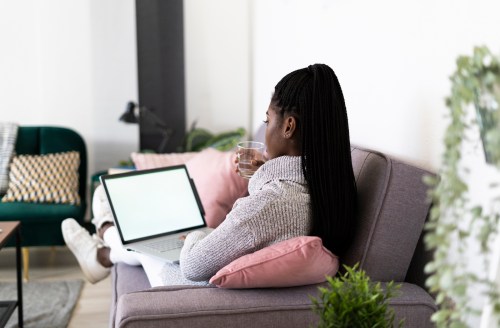A Urologist Explains Exactly How Working From Home Impacts Bladder Health
A urologist explains whether or not you should be worried about your bladder health at work after working from home for over a year.

How much thought do you give to peeing? If you don’t have any struggles with your bladder—like leaking a little pee when you sneeze or feeling like you have to go all the time—I’d guess not very much. Yet, as many employees consider heading back to the office, you might want to think about your bladder health at work.
Experts in This Article
board-certified urologist and founder of Prestige Medical Group in Santa Ana, California
Pre-pandemic, when you were at work all day and out and about with friends on the weekends, you probably got used to holding your pee. Public bathrooms don’t offer the same go-whenever-you-want ability as your toilet at home. But spending a year and a half with constant access to private commodes, and getting to go whenever the urge strikes, may have “spoiled” your bladder just a smidge. And an overly-indulged bladder might make going back to the office a little bit harder.
“If we go very often at smaller bladder volumes, the brain will be trained to want to go that often, so the frequency becomes the norm,” says Lamia Gabal, MD, a urologist in Orange County, CA. The gist: Peeing whenever you want makes you want to pee more often. Totally fine if you’re hanging at home all the time. But when we head back to our offices and inevitably fall back into a routine with fewer bathroom breaks, the urge to go can become a problem.
“There’s definitely a ‘sweet spot’ when you have the appropriate urge—before you leak or get pain—but not so often that the bladder becomes overactive due to the brain thinking it’s always time to go,” Dr. Gabal says. On average, a bladder holds 300 to 500cc of pee (a medical term equivalent to a milliliter)—that’s about 10 to 16 ounces, which translates to anywhere between five and seven bathroom breaks per day. Regardless of how much your bladder can hold, it’s a good thing to be able to hold it until the appropriate moment (i.e., when there’s a toilet nearby).
But how much do we actually have to worry about accidents when we return to office life? It’s unlikely that someone with a totally healthy bladder pre-pandemic would have lost enough bladder control to cause significant problems when bathrooms become less available. So, while you might notice a little bladder discomfort when you’re back at your desk, you probably don’t have to worry that you’ll pee your pants.
Bladder discomfort and leakage could be more of a problem, however, for people who have conditions like urinary incontinence or an overactive bladder. Often, urologists will suggest people who have these conditions try something called bladder training, which involves “basically trying to ‘rewire’ the bladder-brain connection,” Dr. Gabal says. Just as your bladder responds to peeing more often with more frequent urges, it can respond to holding your pee in with less frequent impulses.
People who are bladder training gradually try to increase the time between peeing, which can help their bladders hold more urine over time. It’s actually a good thing for people with incontinence or an overactive bladder to have more access to a bathroom than most other people need, Dr. Gabal says. “This can prevent leakage or discomfort,” she says. However, quarantine may have encouraged some to relax their bladder training, meaning they may have lost progress. If you struggle with urinary incontinence or an overactive bladder, consider starting your bladder training up again before heading back to the office. And if bladder training isn’t helping enough, reach out to your primary care doctor or a gastroenterologist. There are many treatment options for overactive bladder and urinary incontinence, Dr. Gabal says.
Your first line of defense is staying away from things that will irritate your bladder, including caffeine, carbonated drinks, and spicy or acidic foods or beverages, the Mayo Clinic explains. The same advice goes for people who don’t have bladder dysfunction but are concerned about their toilet habits. “It’s fine to limit fluids and bladder irritants if you’re not near a bathroom, especially if you don’t have conditions like UTI or kidney dysfunction,” Dr. Gabal says. That’s not an endorsement to dehydrate yourself—it’s still important to drink enough water.
So, even if you don’t have bladder issues, what can you do when you’re back to your 9-to-5? Bladder training may be the answer. As it becomes more clear that you’ll be heading back to an office soon, or as you start making more plans to go out, think a little more carefully about your habits. Should you really be going to the bathroom every time the urge strikes? Or can you hold it a little bit longer? If you train your bladder, the transition back to in-person work might go a bit more smoothly.
Of course, you don’t want to hold your pee to a point where you’re causing damage. “If you can’t urinate when your bladder is filled to capacity, this can lead to harmful conditions such as bladder muscle weakening, UTIs, and incontinence,” Dr. Gabal says. So don’t let bladder training get to a point where you’re feeling pain—that’s a sign that your bladder is too full. Aim for that sweet spot.
Oh hi! You look like someone who loves free workouts, discounts for cutting-edge wellness brands, and exclusive Well+Good content. Sign up for Well+, our online community of wellness insiders, and unlock your rewards instantly.
Sign Up for Our Daily Newsletter
Get all the latest in wellness, trends, food, fitness, beauty, and more delivered right to your inbox.
Got it, you've been added to our email list.










